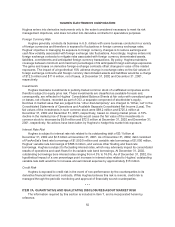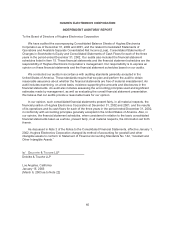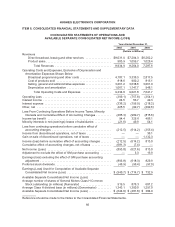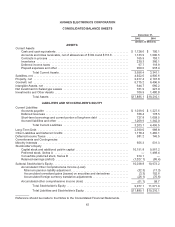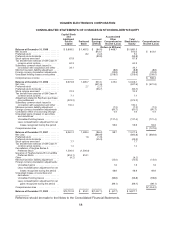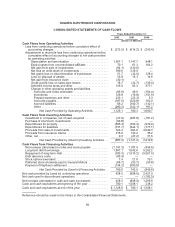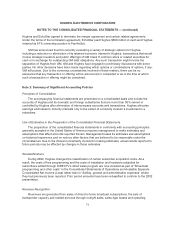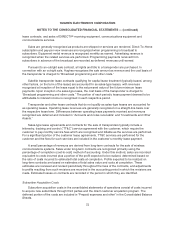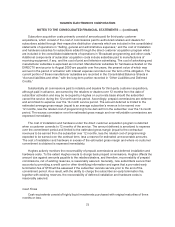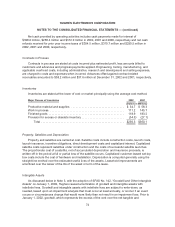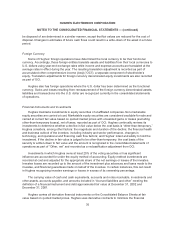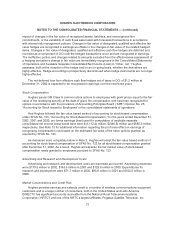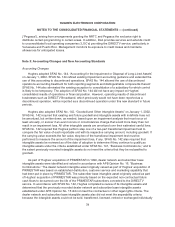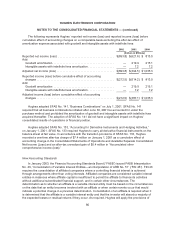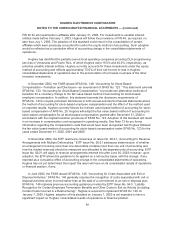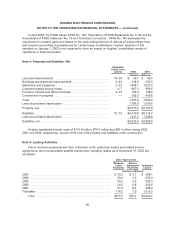DIRECTV 2002 Annual Report Download - page 82
Download and view the complete annual report
Please find page 82 of the 2002 DIRECTV annual report below. You can navigate through the pages in the report by either clicking on the pages listed below, or by using the keyword search tool below to find specific information within the annual report.HUGHES ELECTRONICS CORPORATION
NOTES TO THE CONSOLIDATED FINANCIAL STATEMENTS — (continued)
lease contracts, and sales of DIRECTV®receiving equipment, communications equipment and
communications services.
Sales are generally recognized as products are shipped or services are rendered. Direct-To-Home
subscription and pay-per-view revenues are recognized when programming is broadcast to
subscribers. Equipment rental revenue is recognized monthly as earned. Advertising revenue is
recognized when the related services are performed. Programming payments received from
subscribers in advance of the broadcast are recorded as deferred revenues until earned.
Pursuant to an outright sale contract, all rights and title to a transponder are purchased. In
connection with an outright sale, Hughes recognizes the sale amount as revenue and the cost basis of
the transponder is charged to “Broadcast programming and other costs.”
Satellite transponder lease contracts qualifying for capital lease treatment (typically based, among
other factors, on the term of the lease) are accounted for as sales-type leases, with revenues
recognized at inception of the lease equal to the net present value of the future minimum lease
payments. Upon inception of a sales-type lease, the cost basis of the transponder is charged to
“Broadcast programming and other costs.” The portion of each periodic lease payment deemed to be
attributable to interest income is recognized in each respective period.
Transponder and other lease contracts that do not qualify as sales-type leases are accounted for
as operating leases. Operating lease revenues are generally recognized on a straight-line basis over
the respective lease term. Differences between operating lease payments received and revenues
recognized are deferred and included in “Accounts and notes receivable” and “Investments and Other
Assets.”
Sales-type lease agreements and contracts for the sale of transponders typically include a
telemetry, tracking and control (“TT&C”) service agreement with the customer, which require the
customer to pay monthly service fees which are recognized and billable as the services are performed.
For a significant portion of the customer lease agreements, TT&C services are performed for the
customer and the fees for such services are included in the customer’s monthly lease payment.
A small percentage of revenues are derived from long-term contracts for the sale of wireless
communications systems. Sales under long-term contracts are recognized primarily using the
percentage-of-completion (cost-to-cost) method of accounting. Under this method, sales are recorded
equivalent to costs incurred plus a portion of the profit expected to be realized, determined based on
the ratio of costs incurred to estimated total costs at completion. Profits expected to be realized on
long-term contracts are based on estimates of total sales value and costs at completion. These
estimates are reviewed and revised periodically throughout the lives of the contracts, and adjustments
to profits resulting from such revisions are recorded in the accounting period in which the revisions are
made. Estimated losses on contracts are recorded in the period in which they are identified.
Subscriber Acquisition Costs
Subscriber acquisition costs in the consolidated statements of operations consist of costs incurred
to acquire new subscribers through third parties and the direct customer acquisition program. The
deferred portion of the costs are included in “Prepaid expenses and other” in the Consolidated Balance
Sheets.
72


